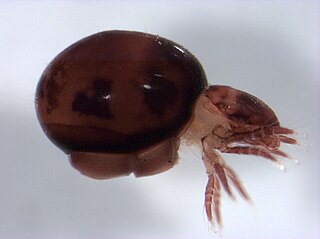
Mesostigmata is an order of mites belonging to the Parasitiformes. They are by far the largest group of Parasitiformes, with over 8,000 species in 130 families. Mesostigmata includes parasitic as well as free-living and predatory forms. They can be recognized by the single pair of spiracles positioned laterally on the body.

Oribatida, also known as oribatid mites, moss mites or beetle mites, are an order of mites, in the "chewing Acariformes" clade Sarcoptiformes. They range in size from 0.2 to 1.4 millimetres. There are currently 12,000 species that have been identified, but researchers estimate that there may be anywhere from 60,000 to 120,000 total species. Oribatid mites are by far the most prevalent of all arthropods in forest soils, and are essential for breaking down organic detritus and distributing fungi.

Brachypylina is a suborder of oribatid mites.

Endeostigmata is a suborder of acariform mites. There are about ten families in Endeostigmata. The grouping is strongly suspected to be paraphyletic, containing unrelated early diverging lineages of mites.

The Laelapidae are a family of mites in the order Mesostigmata. The family is also referred to in the literature as Laelaptidae, which may be the correct spelling.
Ologamasidae is a family of mites in the order Mesostigmata. There are more than 40 genera and 470 described species in Ologamasidae.
Gamasiphis is a genus of mites in the family Ologamasidae. There are more than 60 described species in Gamasiphis.
Euryparasitidae is a family of mites in the order Mesostigmata.
Veigaia is a genus of mites in the family Veigaiidae.

Pachylaelapidae is a family of mites in the order Mesostigmata. There are about 16 genera and more than 200 described species in Pachylaelapidae.
The family Ameroseiidae is one of the three families of mites under the superfamily Ascoidea. There are about 12 genera and more than 130 described species in Ameroseiidae.
Sejidae is a family of mites in the order Mesostigmata. The oldest known record of the group is an indeterminate deutonymph from the mid Cretaceous (Albian-Cenomanian) aged Burmese amber of Myanmar.
Dinychidae is a family of mites in the order Mesostigmata.
Triplogyniidae is a family of mites in the order Mesostigmata.
Cercomegistidae is a family of mites in the order Mesostigmata.

Enarthronota is a suborder of mites in the order Oribatida. There are about 14 families and more than 450 described species in Enarthronota.
Erythracaridae is a family of mites in the order Trombidiformes. There are seven genera accepted within Erythracaridae.
Johnstonianidae is a family of mites in the order Trombidiformes. There are about 7 genera and more than 20 described species in Johnstonianidae.
Pseudocheylidae is a family of mites in the order Trombidiformes. There are at least two genera in Pseudocheylidae.

Sejida is a suborder of mites in the order Mesostigmata. There are about 5 families and 13 described species in Sejida. The oldest known record of the group is an indeterminate deutonymph belonging to Sejidae from the mid Cretaceous (Albian-Cenomanian) aged Burmese amber of Myanmar.








